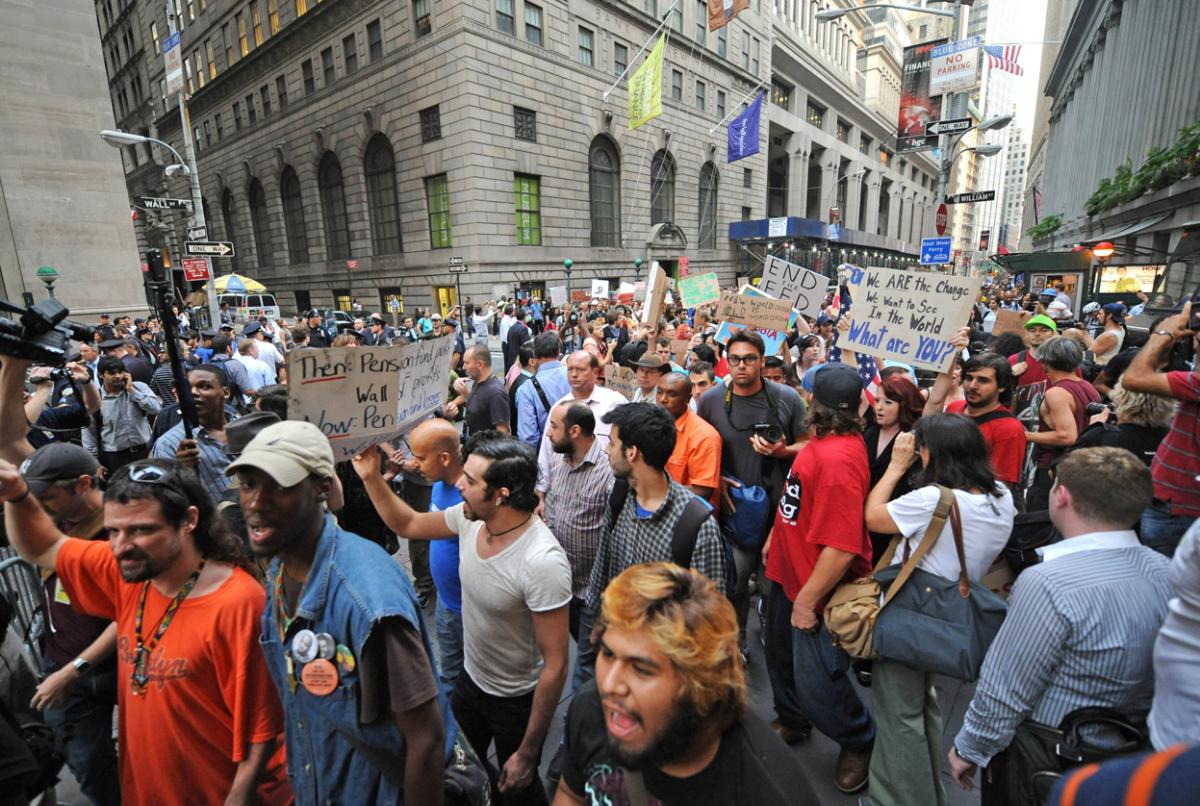Over 30 years of anarchist writing from Ireland listed under hundreds of topics
Review: David Graebers ‘The Democracy Project’.
Date: Mon, 2014-06-30 20:39
 Many of us have an Occupy story. Mine took place in New York on March 17th of 2012, the six-month anniversary of the first occupation of Zuccotti Park, and the three-month anniversary of its eviction. I joined about five hundred or so Occupiers who had gathered after dark on the Manhattan side of Brooklyn Bridge. As we marched the three blocks or so to reclaim Zuccotti Park, NYPD’s finest, fully armed, literally lined the street each step of the way. And in the park itself a surveillance tower loomed overhead.
Many of us have an Occupy story. Mine took place in New York on March 17th of 2012, the six-month anniversary of the first occupation of Zuccotti Park, and the three-month anniversary of its eviction. I joined about five hundred or so Occupiers who had gathered after dark on the Manhattan side of Brooklyn Bridge. As we marched the three blocks or so to reclaim Zuccotti Park, NYPD’s finest, fully armed, literally lined the street each step of the way. And in the park itself a surveillance tower loomed overhead.
What were we doing that was so dangerous that it necessitated a SWAT team on stand-by? No doubt it had something to do with the chanting and singing that started spontaneously once we arrived: ‘Ah! Aquí! An-ti-cap-it-al-is-ta! Ah! Aquí! An-ti-cap-it-al-is-ta!’ Later, there was an attempt to re-camp in Union Square but the following morning, the police arrested or moved on anyone who attempted to remain. I remember a park groundskeeper, an elderly African-American man, spat on the ground as we watched two officers throw a young blue-haired woman into the back of a police van. ‘Same old story’, he said.
Declarations of occupation
David Graeber’s Occupy story is ‘about the possibility of democracy in America [and] the opening up of the radical imagination that Occupy allowed’ (p. xv). ‘The Democracy Project’ is told in five chapters. Chapter one – ‘The Beginning is Near’ – provides a first-hand account of the early days of ‘Occupy’ from the summer of 2011 onwards. Graeber gleefully describes how those who wanted prefigurative politics ignored Marxist-Leninist central committee proposals for ‘popular front’ marches and instead seized the initiative themselves, declaring for a city-square occupation along the lines of Tahrir or Syntagma.
Graeber does not downplay his own organising role here: he helped coin the slogan ‘We are the 99%’ and we are even presented with the emails to prove it. For the most part though, he emphasises the courage, determination and hard work of those dedicated hundreds who dug in at Zuccotti Park that September and refused to budge despite atrocious conditions and police terror.
Within weeks, Occupy had spread to some 800 cities across the world. Chapter two explores why this was the case. Notably, the movement – initially, predominantly composed of indebted graduates and under-employed - spoke directly to America’s wider working class. Highlighting the ‘predatory and unpopular nature of the financial extortion racket’ resonated in a country where the average household spends 18% of its income on servicing loans and where one in seven citizens is being pursued by a debt collection agency. Among the hundreds of individual posts to the ‘We are the 99%’ tumblr, the most frequent word used was ‘job’, the second, ‘debt’, but that almost all the rest referred to necessities of life, homes, food, health care, education, children.
In this context, Graeber claims, Occupy succeeded not despite the ‘anarchist element’ but because of it. Its stubborn refusal to make demands of existing institutions not only attacked ‘institutionalised bribery’ as the basis of contemporary electoral politics, it also tapped into people’s ‘genuine indignation at being cut off from the means of doing good’. In the US, the populist right, notably the Tea Party, had tended to monopolise this indignation; it now had a rival.
Spaces of intercultural improvisation
In the second half of the book, Graeber shows how this apparently new story is, in fact, quite an old one. Chapter three – ‘The Covert History of Democracy’ – argues that, in essence, democracy ‘is just the belief that humans are fundamentally equal and ought to be allowed to manage their collective affairs in an egalitarian fashion, using whatever means appear most conducive. That, and the hard work of bringing arrangements based on those principles into being’. On Graeber’s account, democracy is not an intellectual inheritance, Western tradition or particular mode of government but is rather a constant feature of ‘spaces of intercultural improvisation’ outside of state or church control. In outlining how various spaces of this kind have arisen in the U.S., Graeber links the democratic practices of the indigenous Native Americans, the frontier societies and the pirate vessels of the Atlantic to the popular assemblies and revolts of the American Revolution.
At stake here is a clever inversion of both American exceptionalism and liberal political theory. People’s freedoms are not magically protected for their being enshrined in a constitution or recognised by the state but rather owe, first and foremost, to people actively exercising them.
With this in mind, Chapter four – ‘How Change Happens’ – compares Occupy’s attempts to exercise new freedoms with contemporary revolutionary movements, mostly from the Global South. Here, Graeber identifies a revolutionary ‘dual-power strategy’ with that of creating liberated spaces outside of the existing order and achieving ‘concrete benefits’ for the 99% simultaneously.
In practice, the challenge centres on constructing effective alliances beyond the utopian enclave of activists without compromising on democratic or horizontal decision-making. Graeber contrasts Occupy’s consensus decision-making to the Sadr city strategy in Iraq where grassroots institutions are defended militarily; to the San Andrés strategy in Mexico where the Zapatistas negotiated a separate zone of influence with the Mexican government; and to the El Alto strategy in Bolivia where indigenous social movements, by threatening to topple the government if they go against their elections promises, bolster their political representatives’ negotiating position with capital. To varying degrees, while extracting concessions and delivering ‘concrete benefits’, these strategies present clear limits to horizontality.
Instead, Occupy Wall Street, Graeber suggests, is most like the ‘Buenos Aires’ strategy of creating horizontal practices in order to de-legitimate existing political institutions; material concerns follow secondarily to democratic process. The final chapter – ‘Breaking the Spell’ – interprets the organising tendencies and imaginative horizons at work in Occupy to project the ongoing ‘transformation of political common sense’. On this basis, the revolutionary horizon of the early 21st century might involve some combination of the following: a debt jubilee; an end to the productivist-consumerist work ethic in favour of environmental sustainability and balanced job-life complexes; a shift in labour towards value-creation for human needs; a radical decentralisation of administration and a radical expansion of the baseline communism of everyday life.
An ounce of theory, a tonne of anecdotes
Overall, ‘The Democracy Project’ combines political theory, history and economics with first-hand anecdotes, FAQ sections and a good sense of fun. The result is a very clear and easy to read analysis, consistently attentive to the power relations at stake in both the micro-politics of occupying Zuccotti Park as well as the macro-politics of global political economy.
Any academic can trace how the financial power of the 1% depends on U.S. military might abroad and on the courts, repossession agencies and sheriffs at home; it takes an anarchist activist to convey the true horror of challenging these structures through electoralism, or speechifying celebrities. This realist analysis is central to understanding why the radical horizon suggested by Occupy, howsoever utopian it might at first appear, is absolutely necessary. It also informs why Occupy collapsed: low-level police terror and media smear campaigns prepared the ground for the evictions while, culturally, a decade of post-9/11 security norms allowed liberals to look the other way as the police infringed basic civil liberties to destroy the camps and to make arrests.
In terms of criticism, the intentionally provocative assumption that Occupy ‘worked’ is the central point of the book yet also the one most open to question. After the initial moment of outrage and collective self-help, the movement appeared to stall. Encampments transformed into a meta-movement primarily concerned with defending the right to occupy public space. In this respect, Graeber comes close to acknowledging the limits to Occupy’s securing ‘concrete benefits’ for the 99% but almost instantly insists that the movement’s primary function was to transform political common sense. There are two issues here. First, how does he know? I feel that Graeber too readily discovers his own revolutionary vision in what was a movement with an extraordinarily diverse range of participants and political attitudes. Occupy’s adoption of horizontal means was important but to take this as proof of horizontal ends strains the evidence presented.
Secondly, even if we accept Occupy’s revolutionary potential, Graeber glosses over the practical limitations of horizontalism as a means of social transformation. The suspicion lingers that movements based on square occupations and horizontal assemblies face overwhelming challenges in terms of undermining or exhausting themselves in the long run. This is not simply about police and media hostility; it is also about finding ways to secure ongoing benefits to members, including material ones.
Bread and revolutionary principles
‘The Democracy Project’ clearly identifies the tension in practice between maintaining horizontal principles and achieving concrete benefits but would itself gain, I think, from a more holistic evaluation of how the latter is necessary for the former. There are both practical and principled reasons why anarchist visions of transformation have usually prioritised the general strike and expropriation, or people directly seizing and collectively working the means of production. As Kropotkin put it, revolutionary principles are impossible to sustain without the conquest of bread.
In sum, Graeber’s overall assessment of Occupy’s true significance - a culture shock – is probably right. Occupy reminded us that we need not resign ourselves to having our politics acted upon us. On an unprecedented scale, in occupied squares and cities around the world, people re-discovered and re-invented old habits of self-organisation, and collective action. For a brief period, the movement struck a blow against the prevailing cynicism, a necessary function of neoliberalism’s ‘relentless campaign against the human imagination’ and a powerful force for reinforcing individual isolation in workplaces and communities.
In the years since Occupy, as state and capital continue to isolate, exploit, oppress and repress us, we are still angry but perhaps more tired now, and less hopeful. Books like ‘The Democracy Project’ remind us to take heart. We are many while they are few; there will be new opportunities for revolt; and, above all, the new world struggling to emerge is well worth fighting for.


